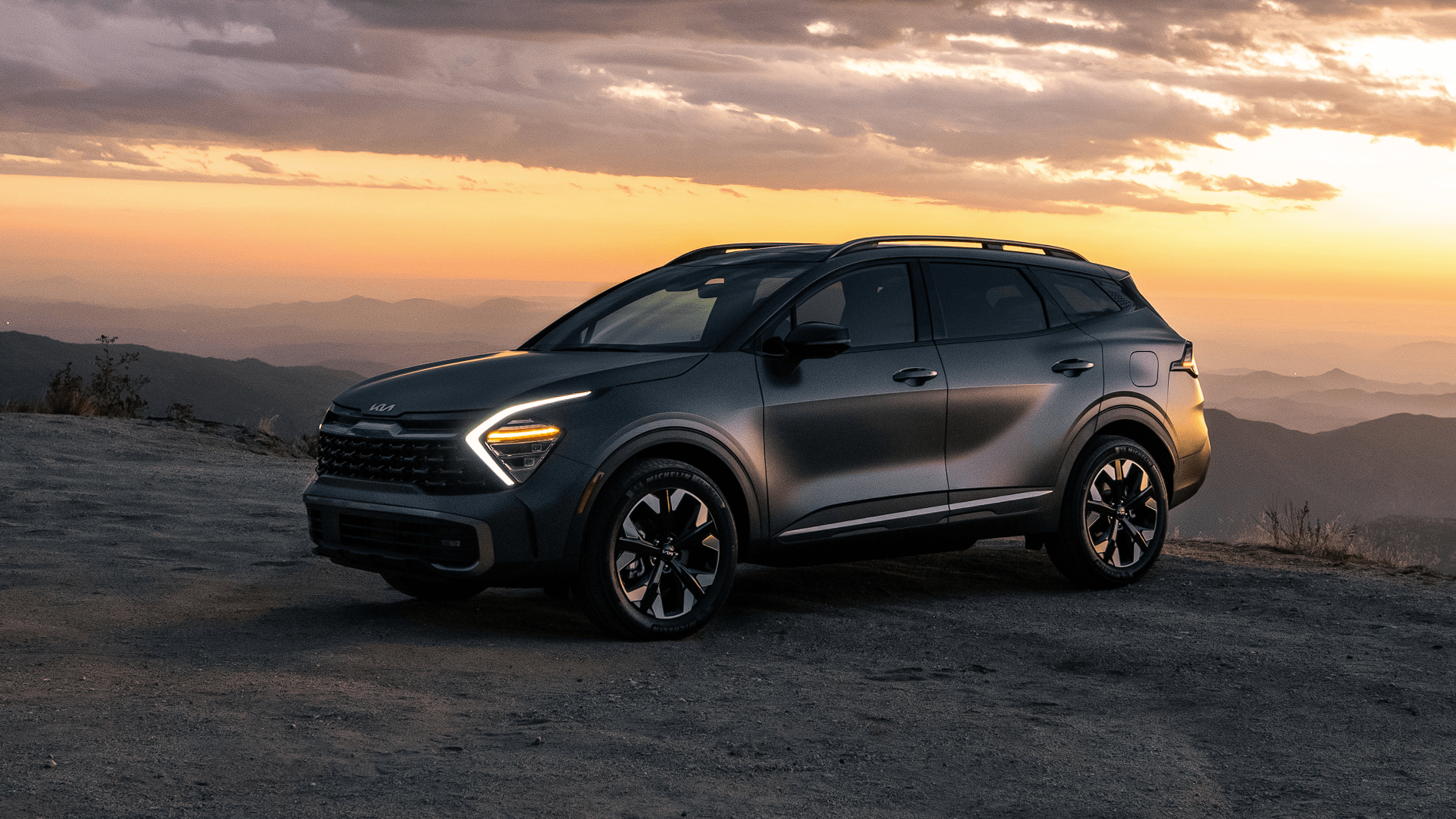2023 Kia Sportage PHEV Smart Cruise Control (SCC)
Smart Cruise Control (SCC), a new type of driver aid that comes with the 2023 Kia Sportage PHEV, will change the way you drive on the highway. SCC combines technology and comfort by using advanced instruments to watch the road ahead. This makes the trip safer and more relaxing. This smart system automatically adjusts your car’s speed to keep a safe distance between it and the car in front, so you don’t have to change your speed all the time in traffic. As you drive in different situations, SCC automatically slows down or speeds up to match the flow of traffic while keeping a safe distance between your Sportage PHEV and the car in front of you. With SCC’s ability to make driving easier and improve safety, the 2023 Kia Sportage PHEV takes a big step toward redefining your driving experience.
2023 KIA SPORTAGE Specs, Price, Features and Mileage (Brochure)
Smart Cruise Control (SCC)
Smart Cruise Control is designed to detect the vehicle ahead and help maintain the desired speed and minimum distance with the vehicle ahead.
Overtaking Acceleration Assist
While Smart Cruise Control is operating, if the function judges that the driver is determined to overtake the vehicle in front, acceleration will be assisted.
Detecting sensor
Front view camera
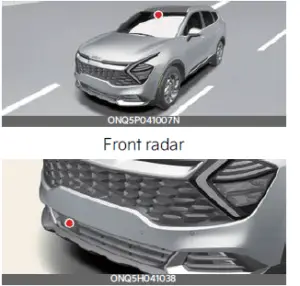
he front view camera and front radar are used as a detecting sensor to detect the vehicles in front.
Refer to the picture above for the detailed location of the detecting sensor.
CAUTION
Always keep the front view camera and front radar in good condition to maintain optimal performance of Smart Cruise Control.
Smart Cruise Control settings To turn on Smart Cruise Control

Press the Driving Assist ( ) button to turn on the function. The speed will be set to the current speed on the cluster.
- If there is no vehicle in front of you, the set speed will be maintained.
- If there is a vehicle in front of you, the speed may be adjusted to maintain the distance to the vehicle ahead. If the vehicle ahead accelerates, your vehicle will travel at a steady cruising speed after accelerating to the set speed.
NOTICE
If your vehicle speed is between 0~20 mph (0~30 km/h) when you press the Driving Assist ( ) button, the set speed will be set to 20 mph (30 km/h).
To set vehicle distance
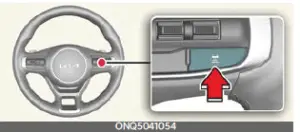
Each time the button is pressed, the vehicle distance changes as follows:
NOTICE
- If you drive at 56 mph (90 km/h), the distance is maintained as follows:
- Distance 4 – approximately 172 ft.(52.5 m)
- Distance 3 – approximately 130 ft.(40 m)
- Distance 2 – approximately 106 ft.(32.5 m)
- Distance 1 – approximately 82 ft. (25 m)
- The distance is set to the last set distance when the vehicle is restarted, or when Smart Cruise Control was temporarily canceled.
To increase set speed
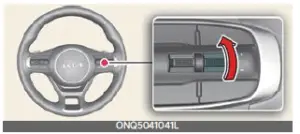
Push the + switch up and release it immediately. The set speed will increase by 1 mph (1 km/h) each time the switch is operated in this manner.
- Push the + switch up and hold it. The set speed will increase by 5 mph (10 km/h) each time the switch is operated in this manner.
- You can increase the set speed to 110 mph (180 km/h).
WARNING
Check the driving condition before using the + switch. Driving speed may sharply increase when you push up and hold the + switch.
To decrease set speed

Push the – switch down and release it immediately. The set speed will decrease by 1 mph (1 km/h) each time the switch is operated in this manner.
- Push the – switch down and hold it.
The set speed will decrease by 5 mph (10 km/h) each time the switch is operated in this manner. - You can decrease the set speed to 20 mph (30 km/h).
To temporarily cancel Smart Cruise Control
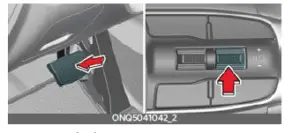
Press the ( ) switch or depress the brake pedal to temporarily cancel Smart Cruise Control.
To resume Smart Cruise Control

To resume Smart Cruise Control after the function was cancelled, operate the +, – or ( ) switch.
- If you push the + switch up or – switch down, vehicle speed will be set to the current speed on the cluster.
- If you push the ( ) switch, vehicle speed will resume to the preset speed.
WARNING
Check the driving condition before using the ( ) switch. Driving speed may sharply increase or decrease when you press the ( ) switch.
To turn off Smart Cruise Control
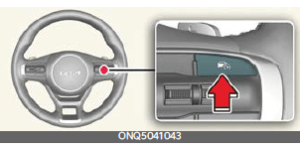
Press the Driving Assist ( ) button to turn Smart Cruise Control off.
NOTICE
If your vehicle is equipped with Manual Speed Limit Assist, press and hold the Driving Assist ( ) button to turn off Smart Cruise Control. However Manual Speed Limit Assist will turn on.
Based on Driving Mode
Smart Cruise Control will change acceleration based on the drive mode selected from Drive Mode Integrated Control function. Refer to the following chart.
| Drive Mode | Smart Cruise Control |
| SMART | Normal |
| SPORT | Fast |
| SNOW | Normal |
| ECO | Slow |
NOTICE
- Smart Cruise Control may not turn on or off in some of the drive modes for the operating conditions are not satisfied.
- If your vehicle is not equipped with Drive Mode Integrated Control system, Smart Cruise Control accelerates your vehicle at a normal level.
Warning Volume

A: Driver Assistance
- Warning Volume
- 2 High
- Medium
- Low
With the vehicle on, select Setup → Driver Assistance → Warning Volume from the User Settings menu or select Setup → Vehicle → Driver Assistance Warning Volume from the infotainment system to change the Warning Volume to High, Medium or Low for Smart Cruise Control.
If you change the Warning Volume, the warning volume of other Driver Assistance systems may change.
NOTICE
If the vehicle is restarted, Warning Volume will maintain the last setting.
Smart Cruise Control operation
Operating conditions
Smart Cruise Control will operate when the following conditions are satisfied.
Basic function
- The gear is in D (Drive)
- The driver’s door is closed
- EPB (Electronic Parking Brake) is not applied
- Your vehicle speed is within the operating speed range
- When there is no vehicle in front: 5~110 mph (10~180 km/h)
- when there is a vehicle in front: 0~110 mph (0~180 km/h)
- ESC (Electronic Stability Control) or ABS is on
- ESC (Electronic Stability Control) or ABS is not controlling the vehicle
- Engine is not running at high RPM
- Forward Collision-Avoidance Assist brake control is not operating
NOTICE
When stopped behind another vehicle, the driver can turn on Smart Cruise Control while the brake pedal is depressed.
Overtaking Acceleration Assist
Overtaking Acceleration Assist will operate when the turn signal indicator is turned on to the left while Smart Cruise Control is operating, and the following conditions are satisfied
- Your vehicle speed is above 40 mph (60 km/h)
- The hazard warning flasher is off
- A vehicle is detected in front of your vehicle
- Deceleration is not needed to maintain distance with the vehicle in front
WARNING
- When the turn signal indicator is turned on to the left while there is a vehicle ahead, the vehicle may accelerate temporarily. Pay attention to the road conditions at all times.
- Regardless of your country’s driving direction, Overtaking Acceleration Assist will operate when the conditions are satisfied. When using the function in countries with different driving directions, always check the road conditions at all times.
2023 KIA SPORTAGE Specs, Price, Features and Mileage (Brochure)
Smart Cruise Control display and control
Basic function
You can see the status of Smart Cruise Control operation in the Driving Assist mode on the cluster.
Smart Cruise Control will be displayed as below depending on the status of the function.
- When operating

- Whether there is a vehicle ahead and the selected distance level are displayed.
- Set speed is displayed.
- Whether there is a vehicle ahead and the selected target distance are displayed.
- When the temporarily cancelled
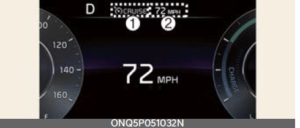
- indicator is displayed.
- The previous set speed is shaded.
NOTICE
- The distance of the front vehicle on the cluster is displayed according to the actual distance between your vehicle and the vehicle ahead.
- The target distance may vary according to the vehicle speed and the set distance level. If vehicle speed is low, even though the vehicle distance have changed, the change of the target vehicle distance may be small.
To temporarily accelerate
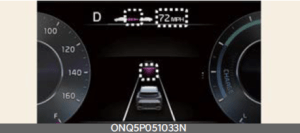
If you want to speed up temporarily without altering the set speed while Smart Cruise Control is operating, depress the accelerator pedal. While the accelerator pedal is depressed, the set speed, distance level and target distance will blink on the cluster.
However, if the accelerator pedal is depressed insufficiently, the vehicle may decelerate.
WARNING
Be careful when accelerating temporarily, because the speed and distance is not controlled automatically even if there is a vehicle in front of you.
Smart Cruise Control temporarily cancelled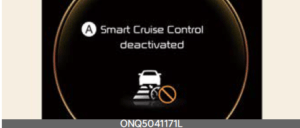
A: Smart Cruise Control deactivated
Smart Cruise Control will be temporarily cancelled automatically when:
- The vehicle speed is above 120 mph (190 km/h)
- The vehicle is stopped for a certain period of time
- The accelerator pedal is continuously depressed for a certain period of time
- The conditions for Smart Cruise Control to operate is not satisfied
If Smart Cruise Control is temporarily cancelled automatically, a warning message will appear on the cluster, and an audible warning will sound to warn the driver.
NOTICE
If Smart Cruise Control is automatically cancelled temporarily when the vehicle is stopped, the Electronic Parking Brake (EPB) may be applied.
WARNING
When Smart Cruise Control is temporarily cancelled, distance with the front vehicle will not be maintained. Always have your eyes on the road while driving, and if necessary, depress the brake pedal to reduce your driving speed in order to maintain a safe distance.
Smart Cruise Control conditions not satisfied
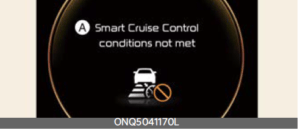
A: Smart Cruise Control conditions not met
If the Driving Assist button, + switch, – switch or ( ) switch is pushed when Smart Cruise Control’s operating conditions are not satisfied, a warning message will appear on the cluster, and an audible warning will sound.
In traffic situation
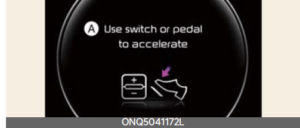
A: Use switch or pedal to accelerate
In traffic, your vehicle will stop if the vehicle ahead of you stops. Also, if the vehicle ahead of you starts moving, your vehicle will start as well.
In addition, after the vehicle has stopped and a certain time have passed, a warning message like above will appear on the cluster. Depress the accelerator pedal or push the + switch, – switch or ( ) switch to start driving.
Warning road conditions ahead

A: Watch for surrounding vehicles
In the following situation, the warning message will appear on the cluster, and an audible warning will sound to warn the driver of road conditions ahead.
- The vehicle in front disappears when Smart Cruise Control maintains the distance with the vehicle ahead while driving below a certain speed.
WARNING
Always pay attention to vehicles or objects that may suddenly appear in front of you, and if necessary, depress the brake pedal to reduce your driving speed in order to maintain a safe distance.
Collision Warning
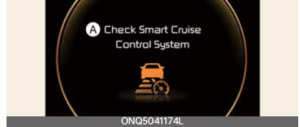
A: Collision Warning
While Smart Cruise Control is operating, when the collision risk with the vehicle ahead is high, a warning message will appear on the cluster, and an audible warning will sound to warn the driver. Always have your eyes on the road while driving, and if necessary, depress the brake pedal to reduce your driving speed in order to maintain a safe distance.
WARNING
In the following situations, Smart Cruise Control may not warn the driver of a collision.
- The distance from the front vehicle is near, and the vehicle speed of the front vehicle is faster or similar with your vehicle
- The speed of the front vehicle is very slow or is at a standstill
- The accelerator pedal is depressed right after Smart Cruise Control is turned on
WARNING
Take the following precautions when using Smart Cruise Control:
- Smart Cruise Control does not substitute for proper and safe driving. It is the responsibility of the driver to always check the speed and distance to the vehicle ahead.
- Smart Cruise Control may not detect unexpected and sudden situations or complex driving situations, so always pay attention to driving conditions and control your vehicle speed.
- Keep Smart Cruise Control off when the function is not in use to avoid inadvertently setting a speed.
- Do not open the door when Smart Cruise Control is operating, even if the vehicle is stopped.
- Always be aware of the selected speed and vehicle distance.
- Keep a safe distance according to road conditions and vehicle speed. If the vehicle distance is too close during high-speed driving, a serious collision may result. Always pay attention to the road conditions ahead.
- When maintaining distance with the vehicle ahead, if the front vehicle disappears, the function may suddenly accelerate to the set speed. Always be aware of unexpected and sudden situations from occurring.
- Vehicle speed may decrease on an upward-sloped road and increase on a downward-sloped road.
- Always be aware of situations such as when a vehicle cuts in suddenly.
- When you are towing a trailer or another vehicle, we recommend that Smart Cruise Control is turned off due to safety reasons.
- Turn off Smart Cruise Control when your vehicle is being towed.
- Smart Cruise Control may be cancelled if interfered by strong electromagnetic waves.
- Smart Cruise Control may not detect an obstacle in front and lead to a collision. Always look ahead cautiously to prevent unexpected and sudden situations from occurring.
- Vehicles moving in front of you with a frequent lane changes may cause a delay in the function’s reaction or may cause the function to react to a vehicle actually in an adjacent lane. Always drive cautiously to prevent unexpected and sudden situations from occurring.
- Always be aware of the surroundings and drive safely, even though a warning message does not appear or an audible warning does not sound.
- If any other function’s warning message is displayed or warning sound is generated, the Smart Cruise Control warning message may not be displayed and warning sound may not be generated.
- You may not hear the warning sound of Smart Cruise Control if the surroundings are noisy. Always pay attention to the road conditions ahead.
- The vehicle manufacturer is not responsible for any traffic violations or accidents caused by the driver while Smart Cruise Control is operating.
- Always set the vehicle speed under the speed limit in your country.
NOTICE
- Smart Cruise Control may not operate for 15 seconds after the vehicle is restarted or the front view camera or front radar is initialized.
- You may hear a sound when the brake is controlled by Smart Cruise Control.
NOTICE
The images or colors may be displayed differently depending on the specifications of the instrument cluster or theme.
Smart Cruise Control malfunction and limitations
Smart Cruise Control malfunction

A: Check Smart Cruise Control System
When Smart Cruise Control is not working properly, a warning message will appear, and the ( ) warning light will appear on the cluster. Have Smart Cruise Control be inspected by a professional workshop. Have Smart Cruise Control inspected by an authorized Kia dealer.
Smart Cruise Control disabled
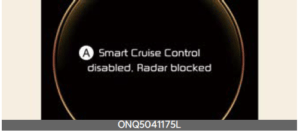
A: Smart Cruise Control disabled. Radar blocked
When the front radar cover or sensor is covered with snow, rain, or foreign material, it can reduce the detecting performance and temporarily limit or disable Smart Cruise Control.
If this occurs, a warning message will appear on the cluster.
Smart Cruise Control will operate normally when snow, rain or foreign material is removed.
WARNING
Even though the warning message does not appear on the cluster, Smart Cruise Control may not properly operate.
CAUTION
Smart Cruise Control may not properly operate in an area (e.g. open terrain), where there is nothing to detect after turning ON the vehicle.
Limitations of Smart Cruise Control
Smart Cruise Control may not operate normally under the following circumstances:
- The detecting sensor or the surroundings are contaminated or damaged
- Washer fluid is continuously sprayed, or the wiper is on
- The camera lens is contaminated due to tinted, filmed or coated windshield, damaged glass, or stuck of foreign material (sticker, bug, etc.) on the glass
- Moisture is not removed or frozen on the windshield
- The field of view of the front view camera is obstructed by sun glare
- Street light or light from an oncoming vehicle is reflected on the wet road surface, such as a puddle on the road
- The temperature around the front view camera is high or low
- An object is placed on the dashboard
- The surroundings are very bright
- The surroundings are very dark, such as in a tunnel, etc.
- The brightness changes suddenly, for example when entering or exiting a tunnel
- The brightness outside is low, and the headlamps are not on or are not bright
- Driving in heavy rain or snow, or thick fog
- Driving through steam, smoke or shadow
- Only part of the vehicle is detected
- The vehicle in front has no tail lights, tail lights are located unusually, etc.
- The brightness outside is low, and the tail lamps of the vehicle in front are not on or are not bright
- The rear of the front vehicle is small or does not look normal (i.e. tilted, over-turned, etc.)
- The front vehicle’s ground clearance is low or high
- A vehicle suddenly cuts in front
- Your vehicle is being towed
- Driving through a tunnel or iron bridge
- Driving near areas containing metal substances, such as a construction zone, railroad, etc.
- A material is near that reflects very well on the front radar, such as a guardrail, nearby vehicle, etc.
- The bumper around the front radar is impacted, or damaged or the front radar is out of position
- The temperature around the front radar is high or low
- Driving in large areas where there are few vehicles or structures (i.e. desert, meadow, suburb, etc.)
- The vehicle in front is made of material that does not reflect on the front radar
- Driving near a highway (or motorway) interchange or tollgate
- Driving on a slippery surface due to snow, water puddles, ice, etc.
- Driving on a curved road
- The vehicle in front is detected late
- The vehicle in front is suddenly blocked by an obstacle
- The vehicle in front suddenly changes lane or suddenly reduces speed
- The vehicle in front is bent out of shape
- The front vehicle’s speed is fast or slow
- With a vehicle in front, your vehicle changes lane suddenly at low speed
- The vehicle in front is covered with snow
- Unstable driving
- You are on a roundabout and the vehicle in front is not detected
- You are continuously driving in a circle
- Driving in a parking lot
- Driving through a construction area, unpaved road, partially paved road, uneven road, speed bumps, etc.
- Driving on an incline road, curved road, etc.
- Driving through a roadside with trees or streetlights
- The adverse road conditions cause excessive vehicle vibrations while driving
- Your vehicle height is low or high due to heavy loads, abnormal tire pressure, etc.
- Driving through a narrow road where trees or grass are overgrown
- There is interference by electromagnetic waves, such as driving in an area with strong radio waves or electrical noise
- Driving on a curved road
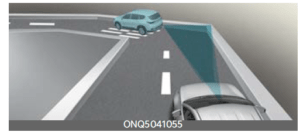
On curved roads, Smart Cruise Con-trol may not detect a vehicle in the same lane, and may accelerate to the set speed. Also, vehicle speed may rapidly decrease when the vehicle ahead is detected suddenly.
Select the appropriate set speed on curved roads and apply the brake pedal or accelerator pedal according to the road and driving conditions ahead.
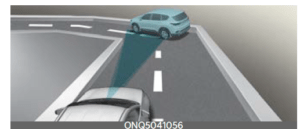
Your vehicle speed can be reduced due to a vehicle in the adjacent lane.
Check to be sure that the road conditions permit safe operation of Smart Cruise Control and if necessary, depress the brake pedal to reduce your driving speed in order to maintain a safe distance.
- Driving on a sloped road
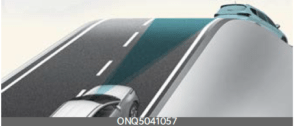
During uphill or downhill driving, Smart Cruise Control may not detect a moving vehicle in your lane, and cause your vehicle to accelerate to the set speed. Also, vehicle speed will rap-idly decrease when the vehicle ahead is detected suddenly.
Select the appropriate set speed on sloped roads and apply the brake pedal or accelerator pedal according to the road and driving conditions ahead.
- Changing lanes
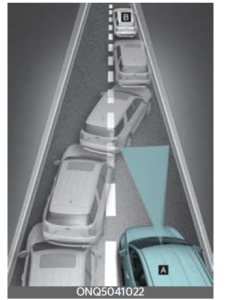
[A]: Your Vehicle
[B]: Lane changing vehicle
When a vehicle moves into your lane from an adjacent lane, it cannot be detected by the sensor until it is in the sensor’s detection range. Smart Cruise Control may not immediately detect the vehicle when the vehicle changes lanes abruptly. Always pay attention to the road and driving conditions and drive safely. If necessary, depress the brake pedal to reduce your driving speed in order to maintain a safe distance.
[B]: Lane changing vehicle
When a vehicle moves into your lane from an adjacent lane, it cannot be detected by the sensor until it is in the sensor’s detection range. Smart Cruise Control may not immediately detect the vehicle when the vehicle changes lanes abruptly. Always pay attention to the road and driving conditions and drive safely. If necessary, depress the brake pedal to reduce your driving speed in order to maintain a safe distance.
- Detecting a vehicle
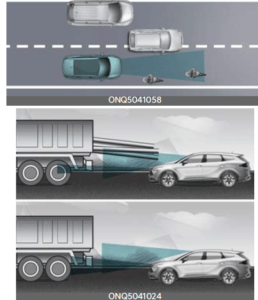
In the following cases, some vehicles in your lane cannot be detected by the sensor:
-
- Vehicles offset to one side
- Slow-moving vehicles or sudden
- decelerating vehicles
- Vehicles with higher ground clearance or vehicles carrying loads that stick out of the back of the
- vehicle Vehicles that has the front lifted due to heavy loads
- Oncoming vehicles
- Stopped vehicles
- Vehicles with small rear profiles, such as trailers
- Narrow vehicles, such as motorcycles or bicycles
- Special vehicles
- Animals and pedestrians
- Vehicle at a short distance (about
In the following cases, the vehicle in front cannot be detected by the sensor. Always pay attention to the road and driving conditions and drive safely. If necessary, adjust your vehicle speed.
-
- You are steering your vehicle
- Driving on narrow or sharply curved roads
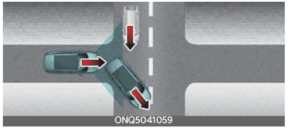
When a vehicle ahead disappears at an intersection, your vehicle may accelerate.
Always pay attention to road and driving conditions while driving.
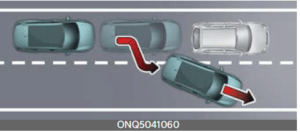
- When a vehicle in front of you merges out of the lane, Smart Cruise Control may not immediately detect the new vehicle that is now in front of you.
Always pay attention to road and driving conditions while driving.

- Always look out for pedestrians when your vehicle is maintaining a distance with the vehicle ahead.
This device complies with Part 15 of the FCC rules.
Operation is subject to the following three conditions:
- This device may not cause harmful interference, and
- This device must accept any interference received, including interference that may cause undesired operation. Changes or modifications not expressly approved by the party responsible for compliance could void the user’s authority to operate the device.
Radiofrequency radiation exposure information:
This equipment complies with FCC radiation exposure limits set forth for an uncontrolled environment. This equip-ment should be installed and operated with minimum distance of 8 inches (20 cm) between the radiator (antenna) and your body. This transmitter must not be collocated or operating in conjunction with any other antenna or transmitter.
FAQ
Smart Cruise Control is an advanced driving assistance feature that automatically adjusts your vehicle’s speed to maintain a safe following distance from the vehicle ahead.
SCC uses sensors, such as radar or cameras, to detect the speed and distance of the vehicle in front. It adjusts your vehicle’s speed by automatically accelerating or decelerating.
No, SCC is more advanced than traditional cruise control because it adjusts your vehicle’s speed to match the traffic flow and maintain a safe distance from the vehicle ahead.
SCC and adaptive cruise control are often used interchangeably; both refer to the same technology that adjusts speed based on traffic conditions.
Yes, you can set a specific cruising speed, but SCC will automatically adjust that speed to maintain a safe following distance.
Activate SCC through the vehicle’s settings or steering wheel controls. Consult the owner’s manual for specific instructions.
Yes, SCC usually allows you to adjust the following distance between your vehicle and the one ahead using the vehicle’s controls.
Yes, many SCC systems include stop-and-go functionality, allowing the vehicle to come to a complete stop and resume automatically in traffic.
Some SCC systems can bring your vehicle to a complete stop, while others might require driver intervention to stop completely.
If SCC comes to a complete stop, you’ll usually need to tap the accelerator pedal to resume driving.
Some vehicles allow you to switch between SCC and regular cruise control modes through the vehicle’s settings.
Some advanced SCC systems have the ability to recognize stationary vehicles and pedestrians, but this capability can vary.
SCC’s performance might be affected by adverse weather conditions like heavy rain or snow, depending on the system’s sensors.
Yes, you can usually override or cancel SCC manually by applying the brakes or accelerating. Check the owner’s manual for details.
SCC availability can vary by trim level and package. Verify with Kia or consult the vehicle’s specifications.
Useful Link
View Full PDF: Kia Sportage PHEV 2023 User Guide | Autouser Guide
Kia Sportage PHEV 2023 Blind-Spot View Monitor (BVM) and Cruise Control (CC) User Guide
2023 KIA SPORTAGE Specs, Price, Features and Mileage (Brochure)
Related Article
2023 KIA SPORTAGE Specs, Price, Features, Mileage (Brochure)

